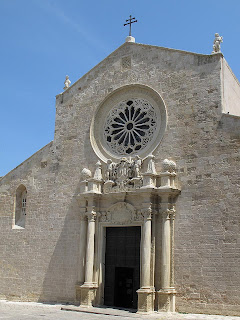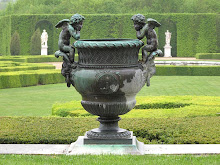Tucked in a cove on the farthest southeast coast of Italy survives the small town of Otranto. Since recorded history and likely before, it's been a crossroad of commerce, culture, and conquest. In all our travels we haven't come across of a town with such a trampled past. Greeks, Romans, Turks, Byzantine emperors, Dukes, French, Neopolitans among others -- and most recently tourists -- have captured it's inhabitants. This far south, there survives many remnants of this varied past, including a functioning 12th century Norman clock tower.
The important site here is the town's main cathedral. In 1480, an Ottoman Turkish fleet suddenly invaded Otranto and demanded of it's Christian inhabitants to convert to the Muslim faith. Residents refused to capitulate, and some 800 townsfolk were taken to the hills and beheaded. During the same year, the town was rescued and a castle was built to proudly protect future inhabitants.
In a side chapel, the exhumed bones of the beheaded are now stacked on display within glass chambers, as a testament of their faith. Macabre or moving? These poor souls have since received sainthood and a similar display exists in Naples.
More amazing is the recently restored mosaic tile floor. In 1166, an over-zealous and obviously creative priest took over two years to cover the entire cathedral floor with 1cm coloured tiles, some 300 years before Columbus sailed for North America. The floor was completely restored a few years ago and church services still take place on the mosaic, although during the day the most important parts are protected from tours and school groups.
DM











No comments:
Post a Comment